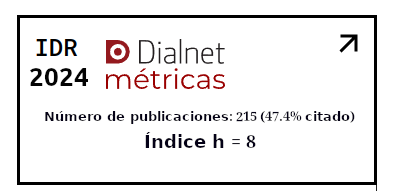Impact evaluation of teaching Calculus online using the Case Method
DOI:
https://doi.org/10.30545/academo.2024.may-ago.10Keywords:
Didactic strategy, online teaching, decision-making, management education, calculus teaching, case method, impact evaluationAbstract
As a result of the COVID 19 pandemic, a set of modifications were implemented in the way it was taught. Higher education institutions in Chile were not immune to this phenomenon, and to this scenario was added a set of trends that had already been raising the need to review didactics, in terms of what and how it is taught. Different initiatives led to the development and implementation of didactic strategies that sought to solve the challenges faced by the educational system. Even though innumerable articles referring to the implementation of these didactic innovations have appeared, the evidence regarding the impact of their adaptations remains scarce. The objective of this research is to evaluate the impact of the use of the Case Method on the academic performance of the students of the calculus subject of the Business Administration Engineering degree at a Chilean higher education institution in an online context. through a difference-in-differences model using control groups generated with the Propensity Score Matching technique. The results show a positive and statistically significant effect on student grades.
Downloads
References
Anderson, E., & Schiano, B. (2014). Teaching with cases. A practical guide. Harvard Business School Publishing.
Aziza, M. (2020). Relearning the calculus: connecting it to real-life. Wahana Matematika dan Sains: Jurnal Matematika, Sains, dan Pembelajarannya 14(1), 42-53.
Beneitone, P., Esquetini, P., González, J., Marty, M., Siufi, G., & Wagenaar, R. (2007). Reflexiones y perspectivas de la Educación Superior en América Latina. Universidad de Deusto.
Bernasconi, A. (2017). Desafíos del futuro de la educación superior chilena. Temas de Agenda Pública 12(96).
Bressoud, D. (2020). Opportunities for change in the first two years of college mathematics. Bulletin of Mathematical Biology 82, 61 https://doi.org/10.1007/s11538-020-00738-7
Chkoniya, V. (2021). Success factors for using case method in teaching applied data science education. European Journal of Education 4(1), 29-38.
Condori, M., & Barrera, F. (2017). Chile Trail & Running: cómo competir. Revista del Centro de Casos de INACAP 5. Centro de Casos de INACAP.
Faulkner, B., Johnson-Glauch, N., Choi, D., & Herman, G. (2020). When am I ever going to use this? An investigation of the calculus content of core engineering courses. Journal of Engineering Education 109(3), 402-423.
Furquim, F., Corral, D., & Hillman, N. (2020). A primer for interpreting and designing difference-in-differences studies in Higher Education research. En Perna (eds.) Higher Education: Handbook of Theory and Research 35. Springer. https://doi.org/10.1007/978-3-030-31365-4_5
Hagman, J. (2021). The eight characteristics for sucessful calculus programs: diversity, equity, & inclusión practices. Problems, Resources, and Issues in Mathematics Undergraduate Studies 31(1), 70-90.
Hagel, P., & Mahoney, D. (1999). Evolving a case study for online delivery. En Interactive teaching and multimedia revolution. Case method & other thechniques. Klein (Ed). WACRA.
He, Y. (2021). The application of case method in the teaching of investment Project evaluation. Journal of Contemporary Educational Research 5(2), 63-67.
Hernández, M., Escobar, C., & Morales, R. (2020). Educational experiences with Generation Z. International Journal on Interactive Design and Manufacturing 14, 847-859.
Herrera, D. (2019). Credencialismo educativo y desigualdades estructurales persistentes en la era de la modernización de España. Tendencias Sociales. Revista de Sociología 4, 99-115.
Hughes, C., & Hewson, L. (1988). Online interactions: developing a neglected aspect of the virtual classroom. Educational Technology 38(4), 48-55.
Hoy, W., & Adams, C. (2016). Quantitative research in education: A primer. SAGE Publications.
Kofler, I., Innerhofer, E., Marcher, A., Gruber, M., & Pechlaner, H. (2020). The jungle of skills mismatch. En: The Future of High Skilled Workers. Palgrave Pivot, Cham. https://doi.org/10.1007/978-3-030-42871-6_3
Lindeman, B., Kent, T., Kinzie, M., Larsen, V., Ashmore, L., & Becker, F. (1995). Exploring cases on-line with virtual environments. CSCL 95 Proceedings, 214-217.
MGI. (2021). Defining the skills citizens will need in the future world of work. https://www.mckinsey.com/industries/public-and-social-sector/our-insights/defining-the-skills-citizens-will-need-in-the-future-world-of-work#
OCDE (2019). Perspectivas de empleo de la OCDE 2019. https://read.oecd-ilibrary.org/emplo yment/perspectivas-de-empleo-de-la-ocde-2019_bb5fff5a-es#page65
Onyema, E., Chika, N., Ayobamidele, F., Sen, S., Grace, F., Sharma, A., & Alsayed, A. Impact of coronavirus pandemic on education. Journal of Education and Practice 11 (13), 108-121.
Palyanitsina, A., & Akhmedova, A. (2020). Implementing the case study method in a process of teaching oil engineers. Journal of Physics: Conference Series 1515 https://doi:10.1088/1742-6596/1515/2/022049
Powell, M., Hull, D., & Beaujean, A. (2020). Propensity score matching for education data: worked examples. The Journal of Experimental Education 88(1), 145-164.
Puri, S. (2020). Effective learning through the case method. Innovations in Education and Teaching International. https://doi.org/10.1080/147 03297.2020.1811133
Pokhrel, S., & Chhetri, R. (2020). A literature review on impact of COVID-19 pandemic on teaching and learning. Higher Education for the Future 8(1), 133-141.
Schiano, B., & Andersen, E. (2017). Teaching with cases online. Harvard Business Review, 25, 1-31.
Schiano, B. (2020). Mastering case teaching in online classes. Harvard Business Publishing. https://www.hbsp.harvard.edu/inspiring-minds/mastering-case-teaching-in-online-classes
Silge, J., & Robinson, D. (2017). Text mining with R. O’Reilly.
Vitvytska, S., Kovalchunk, I. (2021). Application of case technology in the process of teaching chemistry to future specialists in the field of pharmacy. Zhytomyr Ivan Franko State University Journal. Pedagogical Science 1(104), 59-68.
Wasserman, S. (2006). El estudio de casos como método de enseñanza. Amorrortu.
Watson, S., & Sutton, M. (2012). An examination of the effectiveness of case method teaching online. Does technology matter?. Journal of Management Education XX (X), 1-20.
Web, H., Gill, G., & Poe, G. (2005). Teaching with the case method online: pure versus hybrid approaches. Decision Sciences Journal of Innovative Education, 3(2), 223-250.
WEF. (2020). The future of jobs report. World Economic Forum.
Zúñiga, G. (2020). Educación superior técnico profesional en Chile: Análisis del ajuste entre campos de estudio y mercado de trabajo. [Tesis de mestría no publicada]. Universidad de Chile. Disponible en http://repositorio.uchile.cl/ha ndle/2250/177785









